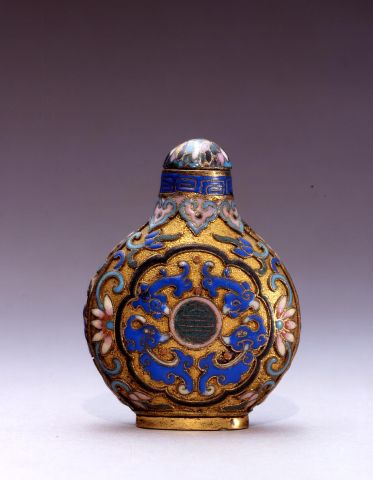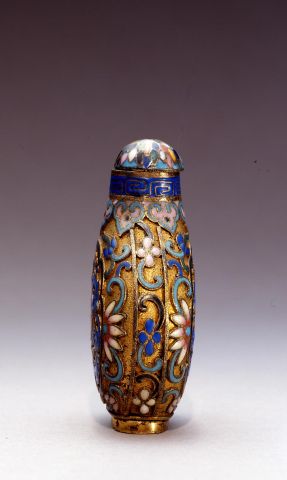

Bottle ID: 332
COPPER, GILDED, CHAMPLEVE
Date: 1770 - 1820
Height: 54 mm
Champleve enamel on gilded copper, of rounded flattened form, enameled in blue, green, turquoise, pink, and white against a gilded ground with archaistic dragons surrounding a shou medallion within a floral vignette surrounded by scrolling lotus and tendrils, the neck with a key-fret band above a trefoil lappet band, the sides with a floral design between two vertical borders.
With original matching stopper.
Similar Examples:
Moss, Hugh M. [ed.] Chinese Snuff Bottles: 6, from the Collection of the Rt. Hon. The Marquess of Exeter, K.C.M.G., 1974, pp. 110 - 111, no. E.30.
Moss, Hugh, Victor Graham and Ka Bo Tsang. The Art of the Chinese Snuff Bottle - The J & J Collection, 1993, Vol II, p. 446, no. 267.
Moss, Hugh, Victor Graham and Ka Bo Tsang. The Art of the Chinese Snuff Bottle - The J & J Collection, 1993, Vol II, pp. 444-445, no. 266 (Cloisonne).
Brinker, Helmut and Albert Lutz. Chinese Cloisonne. The Pierre Uldry Collection, 1989, no. 304.
Provenance:
Clare Lawrence Ltd.
Mr. Bloom, South Africa
This is one example from a small group of bottles, which are all likely to have been produced in the same workshop in the mid Qing period. The design is fairly uniform with the differences between the bottles being in the colors of the enamels and whether the cloisons are completely or partially filled. The bottles are produced by soldering wire ‘walls’ onto a copper or bronze body to form the design element and then filling the resulting areas (known as cloisons) with enamel before the bottle is quickly fired in a low temperature kiln. One further process is used in the ‘completely filled’ group of champleve bottles, that of polishing the entire external surface after firing to give a flat consistency to the bottle. This does not appear to have been done with the ‘partially filled’ bottles leaving the enamel surface both slightly rounded and with a ‘glossier’ look. Few examples of champleve exist outside snuff bottles, but there is a superb 'double' vase in the Uldry Collection (see 'Similar Examples') which is dated to 1786.
< Back to full list
 English
English 中文
中文